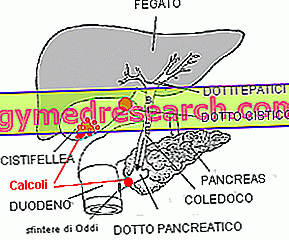Generality
Horton 's arteritis (or giant cell arteritis ) is an inflammatory process that affects medium and large-sized arteries. Although it can affect any arterial vessel, inflammation prefers arteries that cross the head, particularly the temples and neck . Not surprisingly, Horton's arteritis is also known with the third synonym of temporal arteritis .

Figure: a classic sign of Horton's arteritis: the swelling of the artery affected by inflammation . From the site: www.medibird.com
If neglected or not treated properly, Horton's arteritis can have unpleasant consequences.
HORTON ARTERITIS IS A VASCULITE
When we talk about vasculitis we refer to an inflammation of the blood vessels, both arterial and venous. Horton arteritis is a form of vasculitis limited to arterial vessels.
Epidemiology
As will be seen in the chapter on risk factors, Horton's arteritis occurs mainly in old age and in women. Furthermore, there seems to be a greater incidence among people coming from Northern European countries, particularly Scandinavian ones.
Approximately every 4, 500 people get arteritis from an individual every year.
Causes
The precise cause that triggers Horton's arteritis is unclear. According to the most accepted hypothesis, inflammation of the arteries is due to a combination of genetic and environmental factors ; therefore, the presence of only one of the two components is not sufficient to develop the disorder.
NB: When we talk about environmental factors we refer, in the case of Horton's arteritis, to infections of viral or bacterial origin.
PATHOLOGICAL ANATOMY
The arteries are flexible tubes, with a thick but at the same time elastic wall. These vessels carry the oxygenated blood that emerges from the left ventricle of the heart, taking the aorta (the main artery of the human body) to then distribute themselves in arteries of diameter gradually decreasing up to the capillaries.
When the arterial vessels become inflamed, they become abnormally enlarged and prevent normal blood flow. This anatomical change appears to be responsible for the symptoms associated with Horton's arteritis.
RISK FACTORS
Horton arteritis occurs mainly in individuals suffering from polymyalgia rheumatica . In fact, this association concerns about 15% of patients affected by the latter disease, characterized by widespread muscle inflammation, accompanied by pain and muscle stiffness.
The following factors contribute to the development of Horton's arteritis:
- Advanced age : Arteritis is rare in people under the age of 50-55. It is much more frequent, however, from the age of 65-70.
- Female sex : in women, giant cell arteritis is twice as common as in men.
- Scandinavian origin : a greater incidence of the disease was noted among the populations of Northern Europe, in particular those coming from Scandinavia. The reason is, however, unknown.
Symptoms and Complications
To learn more: Symptoms Arteritis of Horton
Horton's arteritis is characterized by a very varied symptomatology; if in the initial stages it can resemble in some ways an influence, it is distinguished from this by a persistent pain in the head, at the temples. Over time, flu-like symptoms worsen and, in addition to headaches, there is also a feeling of soreness (always in the temporal area of the skull), loss of vision and pain in the jaw.
Summing up the symptoms and signs of Horton's arteritis are:
- Headache and feeling of soreness in the temporal area
- Progressive loss of vision and / or double vision
- Scalp soreness (when combing or resting the head on the pillow)
- Jaw pain, especially when the mouth is chewed or spread
- Fever and flu symptoms (feeling tired, stiffness and pain in the neck, shoulder and even muscles, etc.)
- Unexplained weight loss
- Swelling and hardening of the affected arteries (temporal ones, in most cases)
HEAD OF HEAD OR HEADACHE
Persistent temple pain is the main symptom of Horton's arteritis. Usually, it occurs on both sides, but it cannot be ruled out that it may be unilateral or affect the forehead.
NECK PAIN, SHOULDERS AND ALSO

Their absence, therefore, does not necessarily exclude Horton's arteritis.
WHEN TO REFER TO THE DOCTOR?
It is essential to pay attention to the way in which the headache presents itself: if this is persistent and accompanied by the other symptoms mentioned above, in-depth analysis deserves to understand the reasons for its onset.
To avoid unpleasant incidents, it is good to identify Horton's arteritis at the beginning, because it can cause several serious complications, such as blindness.
COMPLICATIONS
There are at least three possible complications related to the appearance of Horton's artertie. The most important is, without doubt, blindness ; the other two, less frequent, are the aortic aneurysm and the stroke .
- Partial and total blindness . It arises due to the swelling, and consequent narrowing, of the arterial vessels that carry oxygenated blood to the eye tissue. In other words, as the blood supply that nourishes the eyes fails, they suffer damage at the cellular level with a dramatic outcome. Vision loss is progressive and, if arteritis is not treated properly, it can become total.
- Aortic aneurysm . As mentioned, Horton's arteritis can affect any arterial vessel of medium and large caliber; the aorta is one of these. Although rare, aortic aneurysm is more common if giant cell arteritis is not treated.
- Stroke . Closer arterial vessels are more likely to be obstructed by a blood clot. If this happens, a stroke may occur.
Diagnosis
To diagnose Horton's arteritis specific tests, both clinical and instrumental, are required, as well as a considerable care on the part of the doctor. The danger, in fact, is that of exchanging the symptoms of this inflammation of the arterial vessels for a trivial influence.
Clinical exams:
- Physical examination
- Blood tests
- Biopsy
The instrumental exams:
- Nuclear magnetic resonance (RMN)
- Doppler ultrasound (ecodoppler)
- Positron emission tomography (PET)
EXAMINATION OBJECTIVE
First of all, the doctor asks about the patient's medical history; in fact, knowing if this is affected by polymyalgia rheumatica (or symptoms that can be traced back to it) is already a very important indication.
Subsequently, it passes to the control of the temporal arteries, observing if there are swellings and other external signs of the vasal inflammation.
BLOOD TESTS
If there is suspicion of a Horton arteritis, the erythrocyte sedimentation test (ESR), performed on the patient's blood, can provide significant information. This test is based on the evaluation of the speed with which the red blood cells sediment at the bottom of the tube that contains them. The faster this movement (high ESR values), the easier it is for inflammation to occur.
Another blood parameter linked to an inflammatory state is the high presence of a particular protein, produced by the liver, known as the C-reactive protein .
Both tests, both sedimentation and C-reactive, are rapid and non-invasive.
BIOPSY
Biopsy is probably the safest and most useful clinical information. Performed under local anesthesia, involves the taking of a small piece of temporal artery and its observation under a microscope.

Figure: Horton's arteritis almost always affects the superficial temporal artery .
From the site: www.vision-and-eye-health.com
To the instrument, the cells of the inflamed arterial vessel appear larger than normal, giants, as the second name of Horton's arteritis says: giant-cell arteritis.
There is, however, a small drawback: it can, by mistake, be taken off a section of the non-inflamed vessel and this causes the result of the examination to be negative (even in the presence of the disease). In these cases, then, proceed by taking a second vessel sample, at a point different from the previous one.
THE INSTRUMENTAL EXAMINATIONS
The instrumental examinations are necessary for the physician, both to confirm the diagnosis and to monitor the effects of therapeutic interventions.
- Nuclear magnetic resonance ( NMR ): using a contrast liquid, it allows the vision of blood vessels and how they change after inflammation. It is not an invasive examination at all.
- Doppler ultrasound ( ecodoppler ): it is, in fact, an ultrasound of the blood vessels. Provides a detailed image of arteries and veins, without any danger to the patient.
- Positron emission tomography ( PET ): by injecting a radiopharmaceutical into the arterial vessels, it is possible to assess whether (and how) their functions changed after inflammation (or after treatment). It is a mildly invasive procedure, because it uses ionizing radiation.
Treatment
For the treatment of Horton's arteritis, it is necessary to use corticosteroid drugs (for example, prednisone ), as they are the only preparations able to stop the inflammation.
HEALING AND MONITORING TIMES
The first effects of the therapy are observed after a few days, although for complete recovery the treatment must be maintained for at least one or two years .
During this time, the progress of inflammation is monitored by means of two reliable and easily executable tests: the erythrocyte sedimentation test and the C-reactive protein test. When the above tests are free of abnormalities, the patient can be considered cured. If doubts persist, the doctor can request a PET.
DOSES
After the first month of therapy, the doses of corticosteroid administered are progressively reduced. Once the minimum quantity able to control inflammation is established, proceed with this until the end of treatment.
SIDE EFFECTS
Side effects of corticosteroid treatment:
- Osteoporosis
- Hypertension (high blood pressure)
- Muscle weakness
- Glaucoma
- Cataract
- Weight gain
- Diabetes (blood glucose levels increase)
- Sensitive skin and easy appearance of hematomas
- Weakening of the immune system
Corticosteroids are very powerful and effective anti-inflammatory drugs, but they can cause numerous side effects, especially when they are taken for a long time.
TIPS TO FOLLOW
During treatment, to keep the side effects related to corticosteroids under control, it is good to follow some tips.
First of all, it becomes essential to correct the diet, so as not to favor the raising of blood pressure and blood sugar (glucose in the blood). Therefore, cooking salt should be moderated and fatty foods, sweets, sugars and alcohol should be reduced in favor of fruit, vegetables, whole grains and lean meat / fish.
Secondly, it is very useful to take supplements based on calcium and vitamin D, against osteoporosis.
Finally, if age allows it, it is important to stay active, in order to favor bone turnover and limit weight gain and muscle tone reduction.
Prognosis
Horton's arteritis, if diagnosed early and treated correctly, resolves itself more than positively.
On the contrary, a late diagnosis and / or an approximate cure can compromise, even significantly, the healing path, thus making the prognosis negative.
For a positive prognosis of Horton arteritis, they are important:
- Early diagnosis
- Immediate corticosteroid therapy
- Proper diet
- Keep active
- Intake of calcium and vitamin D



